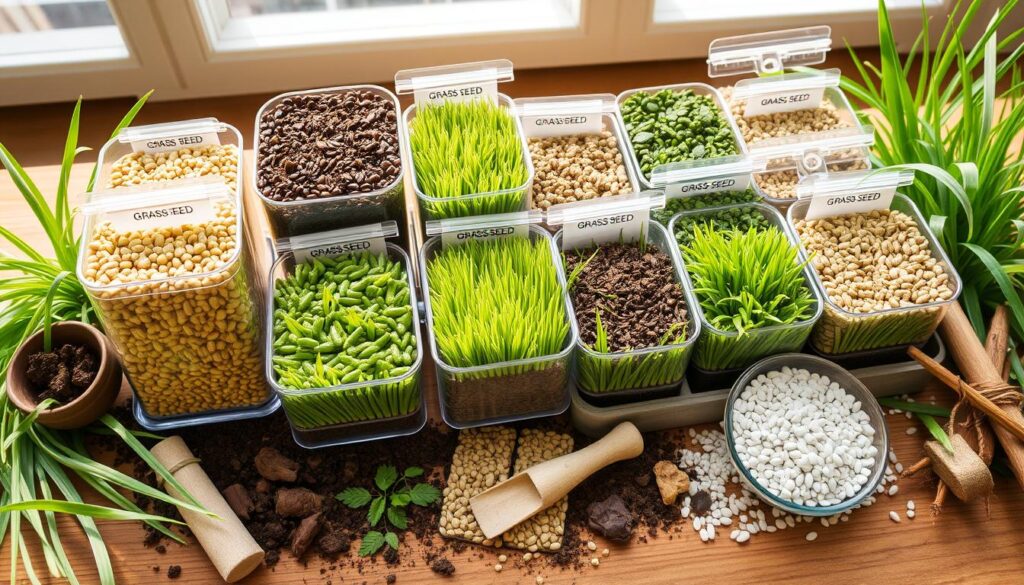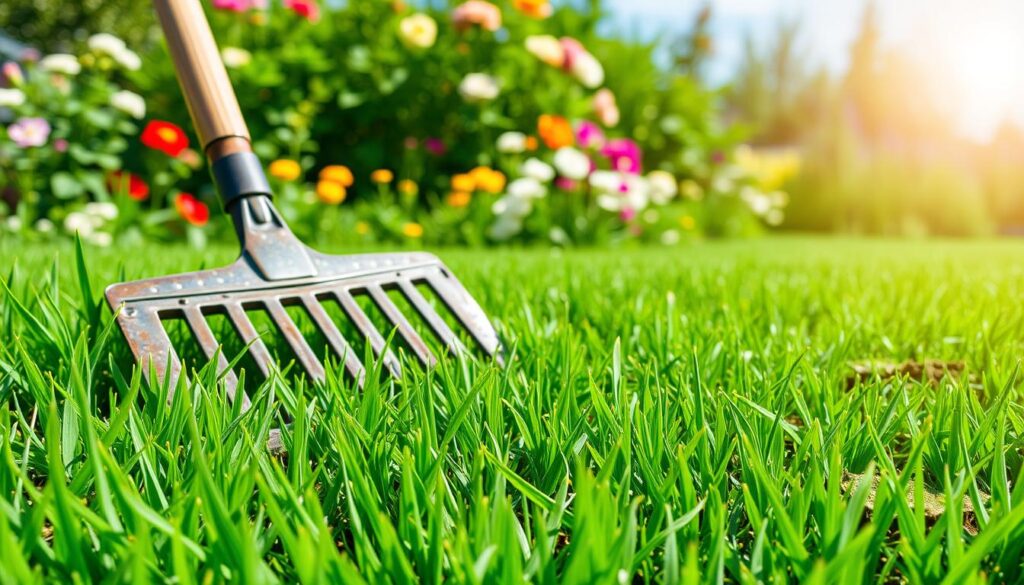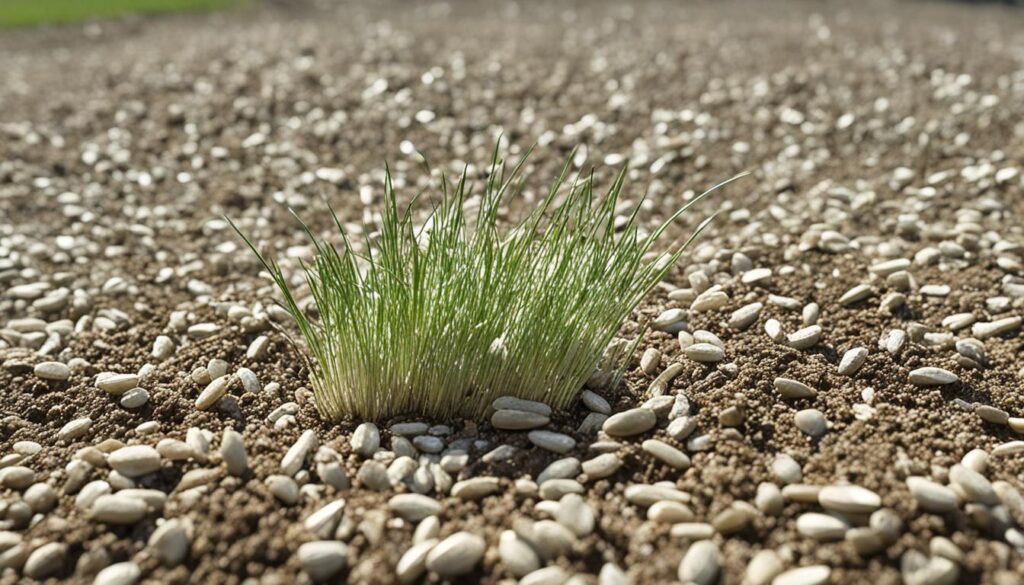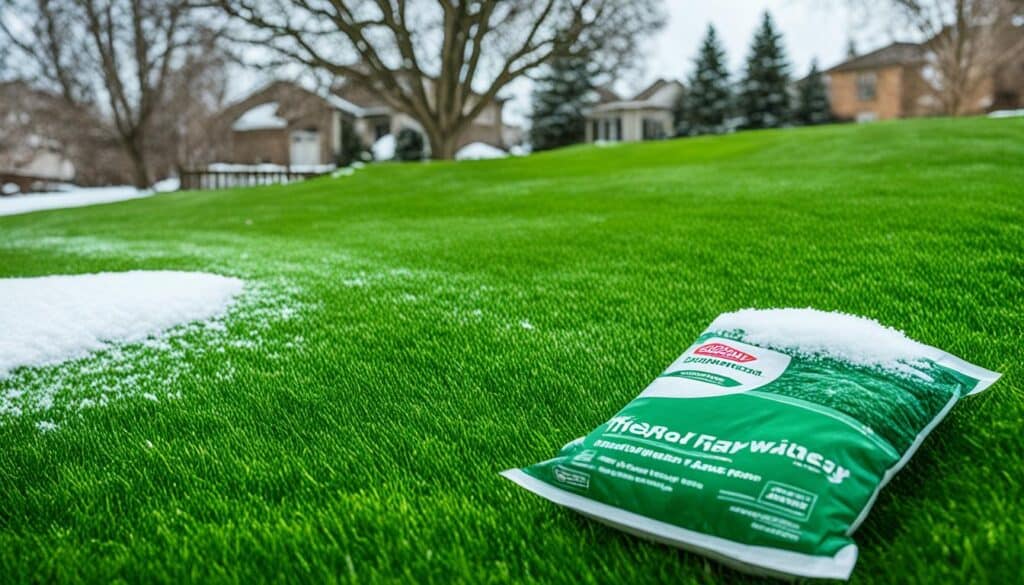Did you know that up to 30% less water is used with Smart Seed grass from Lawn Booster? This shows how much water you can save. If your lawn is dry, full of weeds, or just needs a boost, this guide will help. It will show you how to make your lawn green and healthy again.
Lawn care might seem hard, but it’s not. With the right methods and products, you can make your yard beautiful. This article will teach you when to fix your lawn, how to seed it, and how to keep it looking great.
Key Takeaways
- Discover the optimal time for lawn overseeding and renovation: Mid-August to mid-September, with early spring also viable.
- Learn about the signs that indicate your lawn needs renovation, such as 30-50% dead or sparse grass and excessive thatch buildup.
- Understand the importance of conducting a soil test before starting your lawn renovation project.
- Explore the factors to consider when choosing the right grass seed for your lawn, including sun exposure and maintenance requirements.
- Discover how to properly seed your lawn for even distribution and successful germination.
Understanding When to Renovate Your Lawn
Knowing when to renovate your lawn is key for its health. A lush lawn brings pride and joy. But, it’s hard to know when to act. By spotting renovation signs, you can choose the best ways to improve your lawn.
Signs That Indicate the Need for Lawn Renovation
When 30-50% of your grass is dead or sparse, it’s time to renovate. This can happen due to poor soil, drought, pests, or too much thatch. Also, if your lawn feels soft or weeds are taking over, it’s a sign for renovation.
Regular care and watching your lawn helps catch problems early. This saves time, money, and stress from a bad lawn.
“Staying on top of lawn maintenance and addressing issues as they arise can help you maintain a healthy, vibrant lawn for years to come.”
The best time for renovation is when cool-season grasses grow actively, like spring or fall. This lets new grass grow strong before harsh weather hits. By acting when needed, you can make your lawn a beautiful space.
Conducting a Soil Test
Before starting your lawn renovation, it’s key to do a soil test. This step gives you important info about your soil. It helps you see if it’s missing anything or if it’s not balanced right.
Importance of Soil Testing Before Lawn Renovation
Soil testing is the first step to a great lawn renovation. Knowing your soil’s fertility, pH, and condition helps you plan better. Without this, you might face problems like slow grass growth, weeds, or nutrient shortages.
The University of Minnesota Extension suggests reaching out to your local county extension office. They can help with soil testing and explain what your soil’s characteristics mean.
| Soil Characteristic | Significance |
|---|---|
| pH | Soil pH is measured on a scale of 0 to 14, with ideal lawn soil ranging between 6.0 and 7.0. Acidic soil below 5.5 or alkaline soil above 7.0 can hinder grass growth. |
| Nutrient Levels | Soil testing can reveal deficiencies in key nutrients like nitrogen, phosphorus, and potassium, which are essential for healthy turfgrass development. |
| Soil Texture | The soil’s composition, whether it’s sandy, clay-based, or loamy, affects drainage, water-holding capacity, and nutrient retention – all crucial factors for lawn success. |
| Organic Matter | Healthy soil should contain a sufficient amount of organic matter, which improves soil structure, moisture retention, and nutrient availability. |
Fixing any soil problems before seeding is crucial. It ensures your new lawn thrives and becomes a lush, vibrant space.
Preparing the Lawn for Renovation
Starting a lawn renovation right is key. First, use a non-selective herbicide to kill weeds. Wait 5-14 days for the weeds to die off completely. This makes room for your new grass to grow well.
Then, cut the old lawn very short, about 1 inch. This lets sunlight reach the soil, helping new seeds grow faster. If there’s a lot of thatch, use a vertical mower or sod cutter to get rid of it. Thatch can block seeds from touching the soil, slowing down growth.
Also, aerate the soil if it’s too dense. Compacted soil makes it hard for water and nutrients to get in. A core aerator creates holes, letting air and water in for a healthier lawn.
| Equipment for Lawn Renovation | Purpose |
|---|---|
| Power Rake | Removes thatch buildup |
| Vertical Mower | Cuts through thatch to reach the soil |
| Slit Seeder | Creates grooves for seed deposition |
| Core Aerator | Alleviates soil compaction |
| Water-Filled Roller | Firms seed into the soil |
| Sod Cutter | Removes turf in strips for renovation |
By following these steps, you’ll get your lawn ready for a successful renovation. This will lead to lush, healthy grass.
Selecting the Right Grass Seed
Choosing the right grass seed is key for a successful lawn renovation. Think about your location, sun exposure, and how much maintenance you want. This helps pick the best grass seed for your lawn.
Factors to Consider When Choosing Grass Seed
- Location: Different grass varieties do better in different places and climates. Make sure to pick grass seed that fits your local conditions.
- Sun Exposure: Some grasses love full sun, while others prefer shade. Choose a seed blend that matches your yard’s sun.
- Maintenance Level: Think about how much lawn care you want to do. Some grasses need more mowing, watering, and fertilizing than others.
- Sustainability: Look for non-GMO, sustainable grass varieties that fit your climate. This helps your lawn be lush and green with less care.
The University of Minnesota Extension suggests using a mix of improved Kentucky bluegrass for sunny spots. For shady areas, a fine fescue blend is best.

“Selecting the right grass seed is the foundation for a thriving, sustainable lawn. By considering your local conditions and desired maintenance level, you can choose a seed blend that will give you the lush, vibrant lawn you’ve been dreaming of.”
Properly Seeding Your Lawn
Evenly spreading grass seed is key for a lush lawn. The University of Minnesota Extension recommends dividing the seed into halves or quarters. Then, seed in two or four directions to avoid bare spots and ensure a uniform lawn.
For small areas, hand seeding works well. But for bigger lawns, rotary or drop spreaders are better. These tools spread the seed evenly, helping your lawn grow consistently.
Techniques for Even Seed Distribution
For better lawn renovation, try a slit seeder. It makes shallow slits in the soil for better seed contact. This boosts germination and helps new grass grow well.
- Divide the seed lot into halves or quarters for even distribution
- Seed in two or four directions to ensure comprehensive coverage
- Utilize rotary or drop spreaders for efficient seed distribution on larger lawns
- Employ a slit seeder to create ideal soil contact and improve germination
By using these methods, you can get a lush, overseeded lawn. It will be evenly covered and ready for healthy growth. Proper seeding now will reward you with a vibrant, resilient outdoor space later.
Ensuring Proper Soil Moisture
Keeping the soil moisture right is key for your new lawn to grow well. The University of Minnesota Extension says to water lightly and often. This keeps the soil surface damp but not too wet. It’s important to keep this up until all the grass starts growing, which can take 2-3 weeks for Kentucky bluegrass.
For the best soil moisture in your lawn renovation, follow these tips:
- Water the seeded area 2-3 times a day, for 5-15 minutes each time, to keep it moist but not too wet.
- Change how often and how long you water based on the weather. Water more during hot, dry days and less on cooler, cloudy ones.
- Check the soil moisture by feeling it with your finger. The top inch should be slightly damp.
- Don’t let the soil dry out completely. This can stop the seed germination and harm your new lawn.
By keeping the soil moisture just right, you’ll help your new lawn get off to a great start. It will grow into a lush, healthy, and vibrant grass cover. Remember, good water management is crucial for your lawn renovation to succeed.
Fertilizing Your New Lawn
Proper lawn fertilization is key for your new grass’s health and color. The right nutrients help your lawn start strong and grow well. Let’s look at the different fertilizers and how much to use to make your lawn the best it can be.
Types of Fertilizers and Application Rates
The University of Minnesota Extension suggests using a mix of nitrogen (N), phosphorus (P), and potassium (K) based on a soil test. Don’t add extra nitrogen, as it can harm the new seedlings.
After the first mowing, use 1/2 pound of actual N per 1,000 square feet from a slow-release nitrogen source. This gives your lawn the nutrients it needs to grow without too much stress.
| Fertilizer Type | Application Rate | Timing |
|---|---|---|
| Granular Fertilizer | 1/2 lb N per 1,000 sq ft | Wait 24-48 hours before mowing |
| Liquid Fertilizer | 1/2 lb N per 1,000 sq ft | Can mow within 4 hours after drying |
With the right fertilization, regular mowing, and watering, your new lawn will grow strong and look great.
how long after lawn treatment can you mow
Timing is key when mowing your lawn after treatment. Experts say wait 24 to 48 hours before mowing. This lets the treatment work fully on the grass and soil.
Here’s why waiting is important:
- Weed killers and other chemicals need time to work. Mowing too soon can lessen their effect.
- Leaving grass clippings on helps keep the treatment effective.
- Taller grass gives more area for the treatment to soak in, leading to better results.
Don’t mow right before applying chemicals. Let the grass grow a bit taller. This helps the chemicals reach their targets better.
| Treatment Type | Recommended Mowing Timing |
|---|---|
| Weed Killer | Wait 24-48 hours before mowing |
| Fertilizer | Mow before application for better coverage |
| Insecticide | Shorter grass for contact insecticides, taller grass for systemic |
By following these tips, your lawn care will match up with your treatments. This leads to a healthier, more vibrant lawn.

Lawn Care and Maintenance
Keeping your lawn healthy and green needs careful attention. This includes mowing, watering, and fertilizing. By following the best practices, your lawn will stay vibrant and healthy.
Best Practices for Mowing, Watering, and Fertilizing
Mowing your lawn is key to its health. The University of Minnesota Extension suggests mowing often. This should remove no more than one-third of the leaf blade at a time. This method encourages healthy growth and prevents uneven patches.
It’s also important to wait 24-48 hours after applying fertilizer before mowing. This allows the nutrients to be fully absorbed by the grass.
Watering your lawn correctly is also vital. Adjust your watering schedule based on weather. During dry times, aim to give your lawn 1-1.5 inches of water per week. Make sure to avoid mowing when the grass is wet to prevent damage.
Regular fertilization with high-quality products is essential. Always follow the application instructions and wait the recommended time before mowing. Organic fertilizers can also help keep your lawn healthy and sustainable.
| Lawn Care Task | Best Practices |
|---|---|
| Mowing |
|
| Watering |
|
| Fertilization |
|
By sticking to these mowing, watering, and fertilizing best practices, your lawn will stay lush and green for many years.
Common Lawn Problems and Solutions
Keeping your lawn healthy can be tough, but knowing how to tackle common problems helps a lot. In the Lehigh Valley, people often deal with compacted soil, acidic soil, diseases, pests, and weeds.
Clay soils are common here, causing soil compaction and hurting grass growth. The soil is also very acidic, needing pH treatments to help the grass grow well.
Diseases and pests can cause bare spots and thin grass. It’s important to prevent and treat these issues. Weeds like Nutsedge and Crabgrass can also take over, needing special control.
To fix damaged spots, aeration and overseeding work well. Bumpy lawns need leveling and soil fixes. Discolored lawns might need treatments for drought, disease, or nutrient issues.
Getting help from lawn care experts in Allentown, Lansdale, and Collegeville, PA, is very helpful. With the right help, you can have a beautiful lawn.
| Lawn Problem | Potential Causes | Solutions |
|---|---|---|
| Compacted Soil | Clay soil composition, heavy foot traffic | Aeration, top-dressing with compost |
| Acidic Soil pH | Natural soil conditions in the region | Lime application to raise pH levels |
| Lawn Diseases | Fungal infections, bacterial infections | Fungicides, cultural practices like proper mowing and watering |
| Lawn Pests | Insects, grubs, moles, voles | Integrated Pest Management (IPM) strategies, insecticides |
| Lawn Weeds | Crabgrass, Nutsedge, broadleaf weeds | Pre-emergent and post-emergent herbicides, manual removal |
Conclusion
Reviving a lawn is a rewarding task that needs dedication and care. By following this guide, you can make your lawn lush and vibrant. Each step, from knowing when to renovate to maintaining your lawn, is important.
Be patient, as it takes time for new grass to grow well. Use the right methods and products, like glyphosate and cover crops, for success. Liquid lime helps with pH balance too.
Stay committed to lawn care to enjoy a beautiful, healthy lawn. It will make your property look great. So, get ready, start, and be proud of your lawn’s transformation.
FAQ
How long after lawn treatment can I mow?
The University of Minnesota Extension advises starting with a shorter cut to help new seedlings get sunlight. Once the new grass is as tall as the old, you can raise the mowing height. Keep the mowing short for about a month, or until all seeds have germinated.
What are the signs that indicate the need for lawn renovation?
You might need to renovate your lawn if 30-50% is dead or sparse. If it’s soft, has weeds, or lacks fertility, it’s time for a change. Drought, insects, and too much thatch also point to renovation needs.
Why is it important to conduct a soil test before lawn renovation?
A soil test is key before renovating your lawn. It shows the soil’s health and any issues. Fixing these problems before seeding is crucial for a successful new lawn.
What factors should I consider when choosing grass seed for my lawn renovation?
Think about your location, sun, and maintenance level when picking seed. The University of Minnesota Extension suggests Kentucky bluegrass for sunny spots. For shady areas, fine fescue is better.
How important is it to maintain consistent soil moisture for a newly seeded lawn?
Keeping the soil moist is vital for new lawn growth. Water lightly and often, keeping it damp but not wet. This helps all grass types grow, especially Kentucky bluegrass.
What type of fertilizer should I use for my newly seeded lawn?
Use a fertilizer mix based on your soil test, avoiding too much nitrogen. After the first mow, add 1/2 pound of slow-release nitrogen per 1,000 square feet.
What are some common lawn problems and their solutions?
Your lawn might face weeds, pests, or diseases after renovation. The University of Minnesota Extension advises tackling these early. Use herbicides for weeds, IPM for pests, and fix soil issues to keep your lawn healthy.



